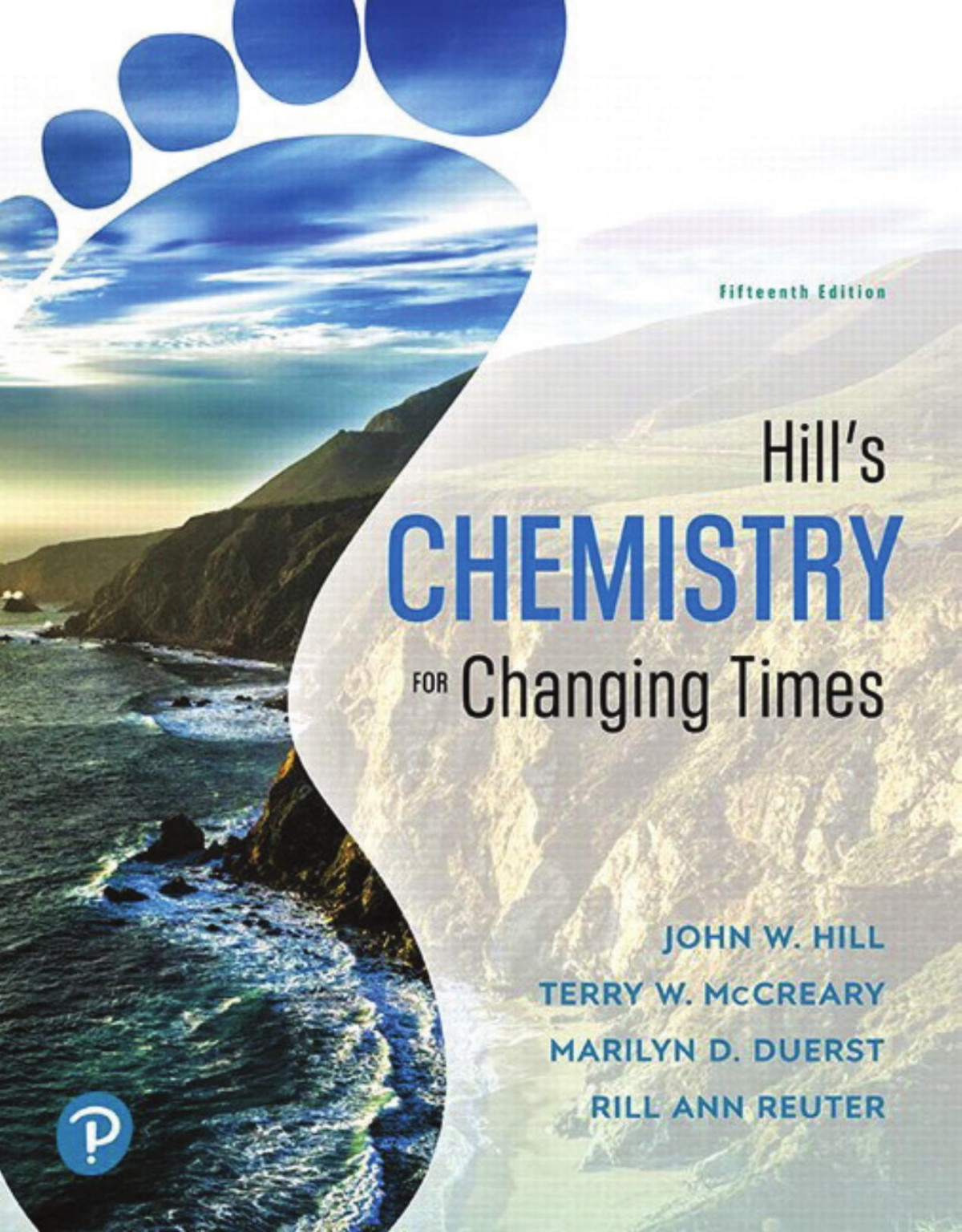(EBook PDF) Hills Chemistry for Changing Times 15th edition by John Hill, Terry McCreary, Marilyn Duerst, Rill Reuter 0134988639 9780134988634 full chapters
$50.00 Original price was: $50.00.$25.00Current price is: $25.00.
Hill’s Chemistry for Changing Times 15th edition by John W. Hill, Terry W. McCreary, Marilyn D. Duerst, Rill A. Reuter – Ebook PDF Instant Download/DeliveryISBN: 0134988639, 9780134988634
Full dowload Hill’s Chemistry for Changing Times 15th edition after payment.

Product details:
ISBN-10 : 0134988639
ISBN-13 : 9780134988634
Author: John W. Hill, Terry W. McCreary, Marilyn D. Duerst, Rill A. Reuter
For non-majors introductory chemistry courses. Engage students with contemporary and relevant applications of chemistry Chemistry for Changing Timeshas defined the liberal arts course and remains the most visually appealing and readable introduction for the subject. Abundant applications and examples fill each chapter and enable students of varied majors to readily relate to chemistry. For the 15th Edition, author Terry McCreary and new coauthors Marilyn Duerst and Rill Ann Reuter, introduce new examples and a consistent model for problem solving. They guide students through the problem-solving process, asking them to apply the models and combine them with previously learned concepts.
Hill’s Chemistry for Changing Times 15th Table of contents:
1 Chemistry
Have You Ever Wondered?
A Science for All Seasons
1.1 Science and Technology: The Roots of Knowledge
1.2 Science: Reproducible, Testable, Tentative, Predictive, and Explanatory
Scientific Data Must Be Reproducible
Scientific Hypotheses Are Testable
Scientific Theories Are Tentative and Predictive
Scientific Models Are Explanatory
The Limitations of Science
1.3 Science and Technology: Risks and Benefits
1.4 Solving Society’s Problems: Scientific Research
Applied Research
Basic Research: The Search for Knowledge
1.5 Chemistry: A Study of Matter and Its Changes
Physical and Chemical Properties
1.6 Classification of Matter
The States of Matter
Substances and Mixtures
Elements and Compounds
Atoms and Molecules
1.7 The Measurement of Matter
Exponential Numbers: Powers of 10
Mass
Length, Area, and Volume
Time
Problem Solving: Estimation
Problem Solving: Unit Conversions
1.8 Density
1.9 Energy: Heat and Temperature
1.10 Critical Thinking
Green Chemistry Green Chemistry: Reimagining Chemistry for a Sustainable World
Summary
Section 1.1
Section 1.2
Section 1.3
Section 1.4
Section 1.5
Section 1.6
Section 1.7
Section 1.8
Section 1.9
Section 1.10
Green Chemistry
Conceptual Questions
Problems
Risk–Benefit Analysis
Mass and Weight
Length, Area, and Volume
Physical and Chemical Properties and Changes
Substances and Mixtures
Elements and Compounds
The Metric System: Measurement and Unit Conversion
Density
Energy: Heat and Temperature
Expand Your Skills
Critical Thinking Exercises
Collaborative Group Projects
Let’s Experiment! Rainbow Density Column
Materials Needed
Questions
2 Atoms
Have You Ever Wondered?
Are They Real?
2.1 Atoms: Ideas from the Ancient Greeks
2.2 Scientific Laws: Conservation of Mass and Definite Proportions
The Law of Conservation of Mass
The Law of Definite Proportions
2.3 John Dalton and the Atomic Theory of Matter
Explanations Using Atomic Theory
Isotopes: Atoms of an Element with Different Masses
2.4 The Mole and Molar Mass
The Mole and Avogadro’s Number
Molar Mass
Problem Solving: Mass, Atom Ratios, and Moles
2.5 Mendeleev and the Periodic Table
Emerging Patterns and Periodicity within the Known Elements
The Periodic Table: Mendeleev and Meyer
2.6 Atoms and Molecules: Real and Relevant
Green Chemistry It’s Elemental
Summary
Section 2.1
Section 2.2
Section 2.3
Section 2.4
Section 2.5
Section 2.6
Green Chemistry
Conceptual Questions
Problems
The Law of Conservation of Mass
The Law of Definite Proportions
John Dalton and the Atomic Theory of Matter
Multiple Proportions
The Mole and Molar Mass
Mass and Atom Ratios
Expand Your Skills
Critical Thinking Exercises
Collaborative Group Projects
Let’s Experiment! Reaction in a Bag: Demonstrating the Law of Conservation of Matter
Materials Needed
Questions
3 Atomic Structure
Have You Ever Wondered?
Images of the Invisible
3.1 Electricity and the Atom
Electrolysis
Cathode-Ray Tubes
Thomson’s Experiment: Mass-to-Charge Ratio
Goldstein’s Experiment: Positive Particles
Millikan’s Oil-Drop Experiment: Electron Charge
3.2 Serendipity in Science: X-Rays and Radioactivity
Röntgen: The Discovery of X-Rays
The Discovery of Radioactivity
3.3 Three Types of Radioactivity
3.4 Rutherford’s Experiment: The Nuclear Model of the Atom
3.5 The Atomic Nucleus
Atomic Number
Isotopes
Symbols for Isotopes
3.6 Electron Arrangement: The Bohr Model (Orbits)
Fireworks and Flame Tests
Continuous and Line Spectra
Bohr’s Explanation of Line Spectra
Ground States and Excited States
Building Atoms: Main Shells
3.7 Electron Arrangement: The Quantum Model (Orbitals/Subshells)
Building Atoms by Orbital Filling
3.8 Electron Configurations and the Periodic Table
Family Features: Outer Electron Configurations
Family Groups
Metals and Nonmetals
Green Chemistry Clean Energy from Solar Fuels
Summary
Section 3.1
Section 3.2
Section 3.3
Section 3.4
Section 3.5
Section 3.6
Section 3.7
Section 3.8
Green Chemistry
Conceptual Questions
Problems
Components of Atoms
Nuclear Symbols and Isotopes
Subshell Notation for Electron Configuration
Expand Your Skills
Critical Thinking Exercises
Collaborative Group Projects
Let’s Experiment! Birthday Candle Flame Test
Materials Needed
Questions
4 Chemical Bonds
Have You Ever Wondered?
The Ties that Bind
4.1 The Art of Deduction: Stable Electron Configurations
4.2 Lewis (Electron-Dot) Symbols
Lewis Dot Symbols and the Periodic Table
4.3 The Reaction of Sodium with Chlorine
The Reaction of Sodium with Chlorine: Theory
Ionic Bonds
4.4 Using Lewis Symbols for Ionic Compounds
The Octet Rule: The Drive for Eight
4.5 Formulas and Names of Binary Ionic Compounds
4.6 Covalent Bonds: Shared Electron Pairs
Multiple Bonds
4.7 Unequal Sharing: Polar Covalent Bonds
Hydrogen Chloride
Electronegativity
Names of Covalent Compounds
4.8 Polyatomic Molecules: Water, Ammonia, and Methane
Water
Ammonia
Methane
4.9 Polyatomic Ions
4.10 Guidelines for Drawing Lewis Structures
Odd-Electron Molecules: Free Radicals
4.11 Molecular Shapes: The VSEPR Theory
4.12 Shapes and Properties: Polar and Nonpolar Molecules
Methane: A Tetrahedral Molecule
Ammonia: A Trigonal Pyramidal Molecule
Water: A Bent Molecule
A Chemical Vocabulary
Green Chemistry Green Chemistry and Chemical Bonds
Summary
Section 4.1
Section 4.2
Section 4.3
Section 4.4
Section 4.5
Section 4.6
Section 4.7
Section 4.8
Section 4.9
Section 4.10
Section 4.11
Section 4.12
Green Chemistry
Conceptual Questions
Problems
Lewis Symbols for Elements
Lewis Structures for Ionic Compounds
Names and Symbols for Simple Ions
Names and Formulas for Binary Ionic Compounds
Names and Formulas for Ionic Compounds with Polyatomic Ions
Molecules: Covalent Bonds
Names and Formulas for Covalent Compounds
Lewis Structures for Molecules and Polyatomic Ions
Electronegativity: Polar Covalent Bonds
Classifying Bonds
VSEPR Theory: The Shapes of Molecules
Polar and Nonpolar Molecules
Molecules That Are Exceptions to the Octet Rule
Expand Your Skills
Critical Thinking Exercises
Collaborative Group Projects
Let’s Experiment! Molecular Shapes: Please Don’t Eat the Atoms!
Materials Needed
Questions
5 Chemical Accounting
Have You Ever Wondered?
Mass and Volume Relationships
Why Chemical “Accounting”?
5.1 Chemical Sentences: Equations
Balancing Chemical Equations
5.2 Volume Relationships in Chemical Equations
5.3 Avogadro’s Number and the Mole
Avogadro’s Number: 6.02⨯1023
The Mole: “A Dozen Eggs and a Mole of Sugar, Please”
Formula Masses
Percent Composition of a Compound from Formula Masses
5.4 Molar Mass: Mole-to-Mass and Mass-to-Mole Conversions
Mole and Mass Relationships in Chemical Equations
Molar Relationships in Chemical Equations
Mass Relationships in Chemical Equations
5.5 Solutions
Solution Concentrations
Molarity
Percent Concentrations
Green Chemistry Atom Economy
Summary
Section 5.1
Section 5.2
Section 5.3
Section 5.4
Section 5.5
Green Chemistry
Conceptual Questions
Problems
Interpreting Formulas
Interpreting Chemical Equations
Balancing Chemical Equations
Volume Relationships in Chemical Equations
Avogadro’s Number
Formula Masses and Molar Masses
Mole and Mass Relationships in Chemical Equations
Molarity of Solutions
Percent Concentrations of Solutions
Expand Your Skills
Critical Thinking Exercises
Collaborative Group Projects
Let’s Experiment! Cookie Equations
Materials Needed
Questions
6 Gases, Liquids, Solids … and Intermolecular Forces
Have You Ever Wondered?
We Introduced the Three States of Matter
6.1 Solids, Liquids, and Gases
6.2 Comparing Ionic and Molecular Substances
6.3 Forces between Molecules
Dipole–Dipole Forces
Dispersion Forces
Hydrogen Bonds
Strength of Intermolecular Forces
6.4 Forces in Solutions
6.5 Gases: The Kinetic–Molecular Theory
6.6 The Simple Gas Laws
Boyle’s Law: Pressure and Volume
Charles’s Law: Temperature and Volume
Molar Volume
6.7 The Ideal Gas Law
Green Chemistry Supercritical Fluids
Summary
Section 6.1
Section 6.2
Section 6.3
Section 6.4
Section 6.5
Section 6.6
Section 6.7
Green Chemistry
Conceptual Questions
Problems
Intermolecular Forces
Boyle’s Law
Charles’s Law
Gay-Lussac’s Law
Molar Volume and Gas Densities
The Ideal Gas Law
Expand Your Skills
Critical Thinking Exercises
Collaborative Group Projects
Let’S Experiment! Blow Up My Balloon
Materials Needed
Questions
7 Acids and Bases
Have You Ever Wondered?
Please Pass the Protons
7.1 Acids and Bases: Experimental Definitions
7.2 Acids, Bases, and Salts
The Arrhenius Theory
Limitations of the Arrhenius Theory
The Brønsted–Lowry Acid–Base Theory
Salts
7.3 Acidic and Basic Anhydrides
Nonmetal Oxides: Acidic Anhydrides
Metal Oxides: Basic Anhydrides
7.4 Strong and Weak Acids and Bases
7.5 Neutralization
7.6 The pH Scale
7.7 Buffers and Conjugate Acid–Base Pairs
Buffer Solutions
7.8 Acids and Bases in Industry and in Daily Life
Antacids: A Basic Remedy
Acids and Bases in Industry and at Home
Acids and Bases in Health and Disease
Green Chemistry Acids and Bases–Greener Alternatives
Summary
Section 7.1
Section 7.2
Section 7.3
Section 7.4
Section 7.5
Section 7.6
Section 7.7
Section 7.8
Green Chemistry
Conceptual Questions
Problems
Acids and Bases: The Arrhenius Theory
Acids and Bases: The Brønsted–Lowry Acid–Base Theory
Acids and Bases: Names and Formulas
Acidic and Basic Anhydrides
Strong and Weak Acids and Bases
Neutralization
The pH Scale
Conjugate Acid–Base Pairs
Antacids
Expand Your Skills
Critical Thinking Exercises
Collaborative Group Projects
Let’S Experiment! Acids and Bases and pH, Oh My!
Materials Needed
Questions
8 Oxidation and Reduction
Have You Ever Wondered?
Burn and Unburn
8.1 Oxidation and Reduction: Four Views
1. Redox as Gain or Loss of Oxygen
2. Redox as Gain or Loss of Hydrogen
3. Gain or Loss of Electrons in Redox Reactions
4. Redox Reactions and Oxidation Numbers
Which of the Four Views Should We Use?
8.2 Oxidizing and Reducing Agents
8.3 Electrochemistry: Cells and Batteries
Dry Cells
Lead–Acid Storage Batteries
Other Batteries
Fuel Cells
Electrolysis
8.4 Corrosion and Explosion
The Rusting of Iron
Protection of Aluminum
Silver Tarnish
Explosive Reactions
8.5 Oxygen: An Abundant and Essential Oxidizing Agent
Oxygen: Occurrence and Properties
Oxygen: Reactions with Other Elements
Oxygen: Reactions with Compounds
Ozone: Another Form of Oxygen
Atomic Oxygen
Other Common Oxidizing Agents
8.6 Some Common Reducing Agents
Metals
Antioxidants
Hydrogen as a Reducing Agent
A Closer Look at Hydrogen
8.7 Oxidation, Reduction, and Living Things
Green Chemistry Green Redox Catalysis
Summary
Section 8.1
Section 8.2
Section 8.3
Section 8.4
Section 8.5
Section 8.6
Section 8.7
Green Chemistry
Conceptual Questions
Problems
Recognizing Oxidation and Reduction
Oxidizing Agents and Reducing Agents
Half-Reactions
Oxidation and Reduction: Chemical Reactions
Combination with Oxygen
Expand Your Skills
Critical Thinking Exercises
Collaborative Group Projects
Let’s Experiment! Light My Fruit
Materials Needed
Questions
9 Organic Chemistry
Have You Ever Wondered?
Organic Chemistry Versus Organic Foods
9.1 Organic Chemistry and Compounds
9.2 Aliphatic Hydrocarbons
Alkanes
Condensed Structural Formulas
Homologous Series
Isomerism—Branched Molecules
Properties of Alkanes
Cyclic Hydrocarbons: Rings and Things
Unsaturated Hydrocarbons: Alkenes and Alkynes
Properties of Alkenes and Alkynes
Geometric Isomers (Cis–Trans Isomers)
9.3 Aromatic Compounds: Benzene and Its Relatives
9.4 Halogenated Hydrocarbons: Many Uses, Some Hazards
Chlorofluorocarbons and Fluorocarbons
9.5 Functional and Alkyl Groups
9.6 Alcohols, Phenols, Ethers, and Thiols
Methyl Alcohol (Methanol)
Ethyl Alcohol (Ethanol)
Toxicity of Alcohols
Multifunctional Alcohols
Phenols
Ethers
Thiols
9.7 Aldehydes and Ketones
Some Common Aldehydes
Some Common Ketones
9.8 Carboxylic Acids and Esters
Carboxylic Acids
Esters: Sweet-Smelling Compounds
9.9 Nitrogen-Containing Compounds: Amines and Amides
Amines
Amides
Heterocyclic Compounds: Alkaloids and Others
Green Chemistry The Art of Organic Synthesis: Green Chemists Find a Better Way
Summary
Section 9.1
Section 9.2
Section 9.3
Section 9.4
Section 9.5
Section 9.6
Section 9.7
Section 9.8
Section 9.9
Green Chemistry
Conceptual Questions
Problems
Organic Chemistry and Organic Compounds
Aliphatic Hydrocarbons
Aromatic Compounds: Benzene and Relatives
Halogenated Hydrocarbons
Functional and Alkyl Groups
Alcohols, Phenols, Ethers, and Thiols
Aldehydes and Ketones
Carboxylic Acids and Esters
Nitrogen-Containing Compounds: Amines and Amides
Expand Your Skills
Critical Thinking Exercises
Collaborative Group Projects
Let’s Experiment! Saturate This!
Materials Needed
Questions
10 Polymers
Have You Ever Wondered?
Giants Among Molecules
10.1 Polymerization: Making Big Ones Out of Little Ones
Natural Polymers
Celluloid: Billiard Balls and Collars
10.2 Polyethylene: From the Battle of Britain to Bread Bags
Types of Polyethylene
Thermoplastic and Thermosetting Polymers
10.3 Addition Polymerization: One + One + One + … Gives One!
Polypropylene
Polystyrene
Vinyl Polymers
PTFE: The Nonstick Coating
Processing Polymers
10.4 Rubber and Other Elastomers
Vulcanization: Cross-linking
Synthetic Rubber
Polymers in Paints
10.5 Condensation Polymers
Nylon and Other Polyamides
Polyethylene Terephthalate and Other Polyesters
Phenol–Formaldehyde and Related Resins
Other Condensation Polymers
Composite Materials
Silicones
10.6 Properties of Polymers
Crystalline and Amorphous Polymers
The Glass Transition Temperature
Fiber Formation
10.7 Plastics and the Environment
Degradable Plastics
Recycling
Plastics and Fire Hazards
Plasticizers and Pollution
Plastics and the Future
Green Chemistry Life-Cycle Impact Assessment of New Products
Summary
Section 10.1—A
Section 10.2
Section 10.3
Section 10.4
Section 10.5
Section 10.6
Section 10.7
People also search for Hill’s Chemistry for Changing Times 15th:
chemistry for changing times (hill and mccreary)
change in h chemistry
change of clocks
change of concentration with time
rate of change chemistry
You may also like…
Uncategorized
Uncategorized
Biology and other natural sciences - Zoology
Fiction
Uncategorized
Ebook
Romance - Contemporary Romance










